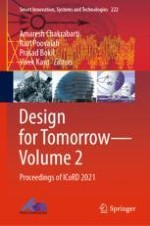2021 | OriginalPaper | Chapter
33. Social Connectedness in Online Versus Face-to-Face Design Education: A Comparative Study in India
Authors : Christy Vivek Gogu, Jyoti Kumar
Published in: Design for Tomorrow—Volume 2
Publisher: Springer Singapore
Activate our intelligent search to find suitable subject content or patents.
Select sections of text to find matching patents with Artificial Intelligence. powered by
Select sections of text to find additional relevant content using AI-assisted search. powered by
